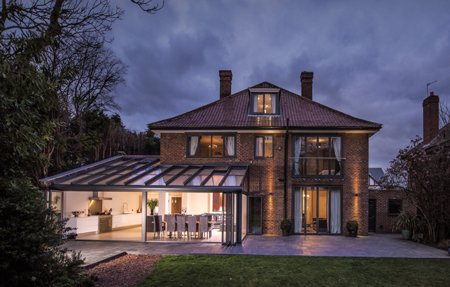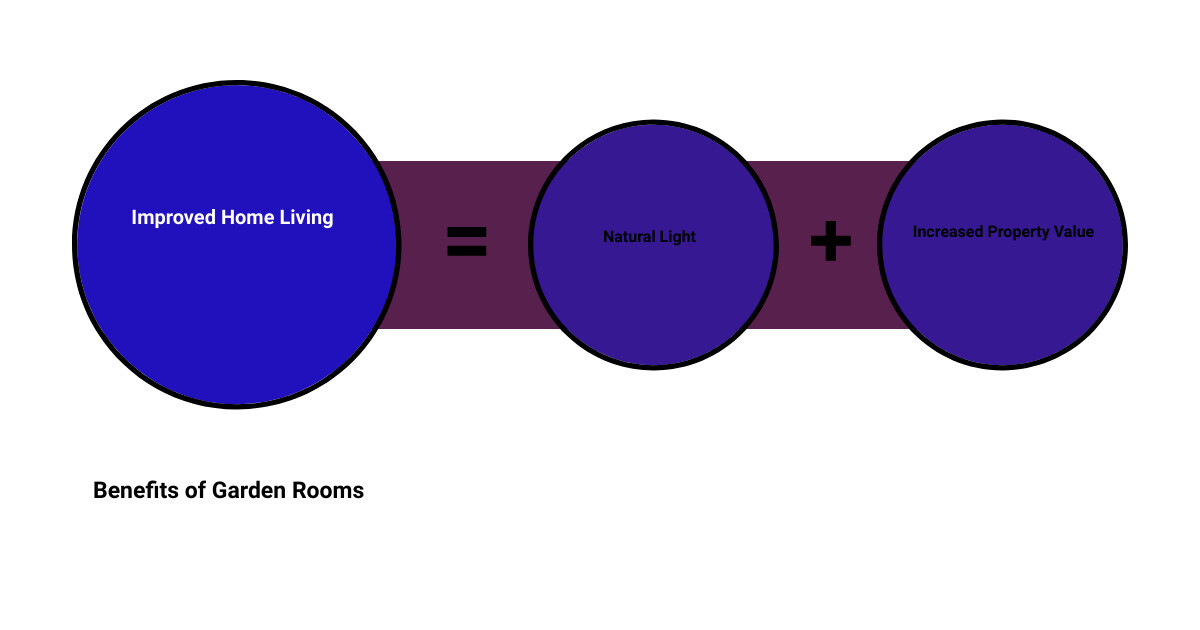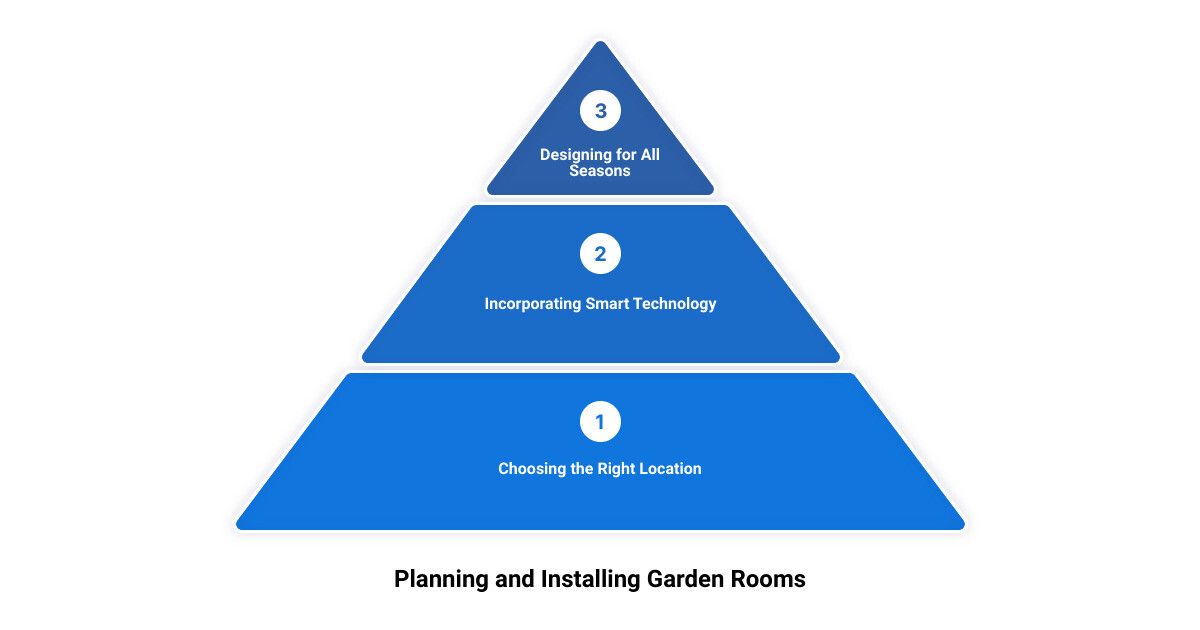
Introduction: The Appeal of Garden Rooms Attached to House
Imagine transforming your outdoor space into a unique and cosy living area that seamlessly integrates with the rest of your house. This is the allure of garden rooms attached to house, a trend that is rapidly gaining popularity among homeowners in the UK. These garden rooms, often fitted with innovative glass strip technology and eco-friendly wood materials, offer a visually appealing and durable addition to your home.
But why are these garden rooms so appealing? Firstly, they offer a cost-effective alternative to traditional house extensions. They provide an additional living space while blending harmoniously with the existing property, thus eliminating the need for a drastic and costly move to a bigger house.
Another major appeal of garden rooms attached to house is their ability to let in an abundance of natural light, creating a brighter and more inviting interior space. Whether you’re looking for a comfortable home office, an extended dining area, or a tranquil spot to unwind, a garden room offers a versatile solution to your space needs.
However, before you jump into this home improvement project, it’s essential to understand the planning permissions required for garden rooms and how to address potential objections from neighbours. Keep reading as we delve into the benefits, installation process, and practical tips for planning and installing garden rooms attached to house. We’ll also introduce you to Glass Verandas UK, a company revolutionizing garden rooms with cutting-edge technology and eco-friendly materials.

The Benefits of Attaching a Garden Room to Your House
There are numerous advantages to integrating a garden room with your existing home structure. From improved natural light to a boost in property value, let’s explore the benefits in detail.
Natural Light and Brighter Interiors
One of the prime benefits of an attached garden room is the abundance of natural light that floods into the space. Glass garden rooms, in particular, are designed to let in sunlight, creating a bright and inviting atmosphere. This natural light not only enhances the visual appeal of the interior but also promotes a sense of well-being, making the space a perfect relaxation or work area. Remember, a brighter room can also mean less reliance on artificial lighting, potentially lowering your energy consumption.
Cost-Effective Home Extension
Garden rooms, especially those attached to the house, are a cost-effective solution for those seeking to expand their living space. Unlike traditional house extensions, which often involve extensive construction work and higher costs, garden rooms offer a more affordable alternative. They can be tailor-made to meet your specific needs, from size to design, without the need for a major structural overhaul of your existing property. Plus, the installation process is usually faster, saving you time as well as money.
Increased Property Value
Finally, attaching a garden room to your house can significantly increase your property’s value. A garden room is an enticing feature for potential buyers, offering additional functional space that can be used for a variety of purposes, from a home office to a playroom. Moreover, a garden room’s aesthetic appeal can make your property stand out in the market. Whether you opt for a modern glass structure or a more traditional wooden design, a garden room can enhance the overall look of your home, making it more appealing to a wide range of potential buyers.
Incorporating a garden room into your home is more than just an upgrade—it’s an investment in your property’s future worth. So, whether you’re planning to sell in the near future or simply want to improve your home for your own enjoyment, attaching a garden room is a decision that can pay off in more ways than one.
Understanding Planning Permissions for Garden Rooms Attached to House
Navigating the realm of planning permissions can be a daunting task, especially when it comes to adding new elements like garden rooms to your home. However, understanding the basic guidelines can help you avoid potential hiccups and ensure your project flows smoothly from conception to completion.
When is Planning Permission Required?
While garden rooms are typically seen as outbuildings, which often don’t require planning permission, the rules can change when you attach these structures to your house. This is because garden rooms attached to your house could be treated as home extensions under the law.
In most cases, if your garden room is less than 50% of the land that the original house covers, you might not need planning permission. However, it is essential to consult your local council’s regulations to be sure. For example, if your garden room is more than 300mm in height, located on the roof of your home, or in the principal elevation of a road or your house, then planning permission might be necessary.
Addressing Neighbour Objections
It’s also crucial to consider your neighbours when planning your garden room. Though it might seem like an internal affair, your neighbours do have the right to object to the construction of your garden room. There are only a handful of reasonable objections that planning will consider, such as overlooking, visual impact, and light disruption.
Overlooking refers to whether your building will be visible and look into your neighbour’s property. Visual impact is a bit harder to contest but will stand in conservation areas. Light disruption entails blocking the sun, which could affect your neighbour’s natural light source.
To avoid these potential issues, it’s best to consult with your neighbours early in the planning stages, addressing any concerns they might have and potentially adjusting your plans to accommodate them.
In conclusion, understanding the need for planning permission and addressing neighbour objections are crucial elements when planning to attach a garden room to your house. By taking these factors into account, you can smoothly navigate the process and bring your garden room vision to life.
Comparing Garden Rooms and Traditional House Extensions
Having navigated the maze of planning permission and neighbour objections, let’s delve into the heart of the matter: how do garden rooms attached to houses stack up against traditional house extensions?
Cost Comparison
First on the agenda is the cost. Traditional house extensions, while offering a significant increase in living space, come with a hefty price tag. The expense is not just in the actual construction, but also in the planning, design, and often lengthy construction process.
On the other hand, garden rooms, like those offered by Glass Verandas UK, present a more budget-friendly alternative. They are typically less expensive to build than traditional extensions, yet still offer a significant increase in space. In fact, these modern spaces are known for delivering a lot of bang for your buck.
Flexibility and Customization
Traditional house extensions often come with limitations in terms of design. They must adhere to the existing structure and style of the house, which can limit your creative freedom.
Garden rooms, however, offer flexibility and customization in spades. Whether you want a closed room, like a free-standing glass room, or an open one linked to another room in your house, garden rooms can be tailored to meet your needs. You can choose the type of glass, frame material, and even the size of the room. This flexibility allows you to create a space that truly reflects your personality and needs.
Speed of Installation
Another advantage of garden rooms is the speed of installation. Traditional house extensions can take months to complete, causing disruption to your daily life. But garden rooms, particularly those built using Structural Insulated Panels (SIPS), can be installed in a matter of weeks, and sometimes even days. For example, Bridge Timber Products completed a large, light, and airy extension in just 12 days. This quick turnaround minimizes disruption and allows you to enjoy your new space sooner.
By considering these factors, you can make an informed decision about whether a garden room or a traditional house extension is the right choice for your home. In terms of cost, flexibility, and speed of installation, garden rooms attached to houses present an appealing alternative to traditional extensions.

Glass Verandas UK: Revolutionizing Garden Rooms with Innovative Technology
The garden room is no longer just an add-on, it has become an essential part of our homes. The right technology and materials can make all the difference in transforming your outdoor space into a cosy haven. Glass Verandas UK is at the forefront of this revolution, bringing innovation and sustainability to garden rooms attached to houses.
Eco-Friendly Materials and Design
One of the most impressive features of Glass Verandas UK is their commitment to eco-friendliness. The company understands the importance of sustainability and reflects this in the materials they use. Their garden rooms are equipped with thermally insulated aluminium roofing, ensuring durability and energy efficiency.
Moreover, they offer an eco-friendly wood option instead of aluminium to overlay the interior veranda structure. They only use FSC and PEFC certified wood like pine, spruce, and larch. This sustainable design approach not only benefits the environment but also provides a natural aesthetic appeal to your garden room.
Seamless Integration with the House
Glass Verandas UK goes the extra mile to ensure your garden room doesn’t just stick out like a sore thumb. They are experts in creating a seamless connection between the house and the garden room. This is achieved through their world-class and innovative glass strip technology, which hides all unsightly screws, creating a continuous visual flow from your house to your garden room.
Whether you have a country home, a detached or semi-detached house, or even a modern city dwelling, Glass Verandas UK will ensure that there is always a synergy between the existing architecture and your new garden room.
Customization Options and Features
Your garden room should be unique to you, able to cater to your specific needs and preferences. Glass Verandas UK offers a variety of configurations, both in terms of design and practical features.
You can choose between an open glass veranda, consisting of a glass roofing system attached to the building, supported by aluminium pillars, and a closed glass veranda, which supplements the open veranda with glass façades or doors, letting you enjoy the space in any weather.
In essence, Glass Verandas UK merges innovation, eco-friendliness, and customization to provide garden rooms that are not only attached to your house but also attached to your lifestyle. The result is a space that is unique, functional, and seamlessly integrated with your home, revolutionizing the way you experience your living space.

Practical Tips for Planning and Installing Garden Rooms Attached to House
Fulfilling your dream of having a garden room attached to your house requires more than just a vision. You need a strategic plan to ensure the end result is a space that not only complements your home, but also enhances your lifestyle. Whether it’s selecting the perfect location, incorporating smart technology, or designing for all seasons – every decision plays a pivotal role in the final outcome. Here are some practical tips to consider.
Choosing the Right Location
The location of your garden room plays a significant role in its functionality and aesthetics. An ideal location would be one that balances the need for privacy, accessibility, and natural light. An attached garden room can be a great extension to your kitchen, living room, or even your bedroom. The right location can drastically influence the ambiance and utility of your garden room, while seamlessly connecting your indoors with the outdoors.
Incorporating Smart Technology
Incorporating smart technology into your garden room can enhance comfort, convenience, and energy efficiency. Consider installing motorized window shades that can be controlled with a remote or smartphone, allowing you to easily adjust the amount of sunlight entering the room. Opt for energy-efficient LED lights with dimmer switches to create a cozy and inviting ambiance. You could also consider implementing smart heating or cooling systems to ensure your garden room is comfortable all year round.
Designing for All Seasons
Designing a garden room that is usable all year round requires careful consideration of various elements. Think about the direction your garden room faces. A south-facing room will get more sunlight, which is ideal for winter, but might require shading solutions for the summer months.
Consider using thermally insulated materials for roofing, as offered by Glass Verandas UK, to ensure your space is warm during the cold months.
Also, think about ventilation – large sliding doors or windows that can be opened wide will help keep the room cool in summer. If you’re planning to use your garden room as a space to entertain guests, including a built-in fireplace or a modern bio-ethanol fire can create a cozy atmosphere during the colder months.
In essence, planning and installing a garden room attached to your house is an exciting home improvement project that requires careful thought and consideration. By choosing the right location, incorporating smart technology, and designing for all seasons, you can create a versatile and appealing space that truly revolutionizes your living experience.
Conclusion: Transform Your Living Space with Garden Rooms Attached to House
Stepping into a world where your living space and nature coexist harmoniously is no longer a distant dream. With garden rooms attached to your house, you can enjoy an unparalleled blend of indoor comfort and outdoor serenity right at your doorstep. Whether it’s a tranquil home office, a vibrant entertainment zone, or a cozy reading nook, the potential uses of these garden rooms are only limited by your imagination.
These additions are more than just a visually stunning extension of your home. They are a testament to your commitment to sustainable living, especially when constructed with eco-friendly materials and designed with energy efficiency in mind. These garden rooms can significantly contribute to your property’s value, making it an investment that pays off in more ways than one.
Navigating the planning permissions for garden rooms attached to the house may seem daunting, but remember that these are generally considered outbuildings and are, therefore, exempt from planning permissions in most cases. Even if you do encounter objections from neighbours, they will only be considered if they pertain to overlooking, visual impact, or light disruption.
When it comes to the choice between garden rooms and traditional house extensions, the former stands out for its cost-effectiveness, flexibility, and speed of installation. You can customize your garden room to fit your unique needs and preferences, and with the use of innovative technology from companies like Glass Verandas UK, you can ensure a seamless and aesthetically pleasing integration with your house.
In conclusion, transforming your living space with garden rooms attached to the house is not just about creating a new room. It’s about embracing a lifestyle that values nature, sustainability, and innovation. It’s about crafting a space that represents your personality and enhances your quality of life. And most importantly, it’s about turning your house into a home where every corner tells a story of beauty, comfort, and harmony. So, are you ready to revolutionize your space?

